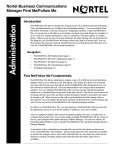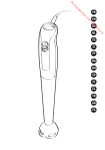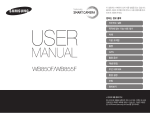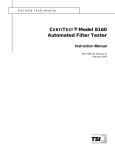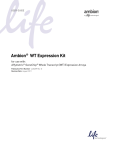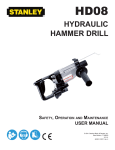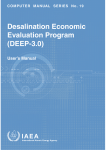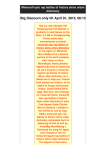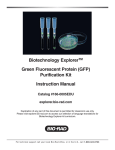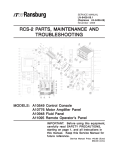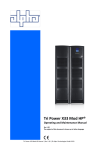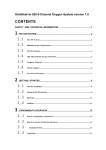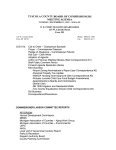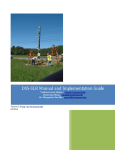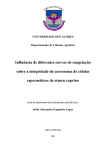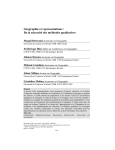Download WHOI-90-35
Transcript
WHOI-90-35 Cc!'j i Woods Hole Oceanographic Institut'ÎoD' II Q' o o. 7 .1930 and Salinity Determination Automated Oxygen Titration by George P. Knapp, 'M.C.' StalcL:pand R.J. Stanley August 1990 Fundingwas provided by the National Science Foundation through Grant No. OCE88-22542. '. Approved for public release; distribution unlimited. DOCUMENT LIBRARY Woods Hole Oceanographic Institution WHOI-9035 Automate Oxgen Titrtion an Saty Detetion by George P. Knapp, M.C. Stalcup and R.J. Staney Woods Hole Oceanographic Institution Woods Hole, Massachusetts 02543 Aut 1990 Tecca Report =- c: Funding was provided by the National Science Foundation -- cO through Grant No. OCE88-22542. ia-- .. Reproduction in whole or in part is permtted for any purpose of the Lt o i: - .J.. . :i c: ~ -. -i -- c: ~ -- c: rr c: c: - United States Government. This report should be cited as: Woods Hole Oceanog. Inst. Technical Report WlIOI-90-35. Approved for public release; distribution unlimited. Approved for Dibution: ~~ Department of Physical Oceanography TABLE OF CONTENS ~ Abstract 1 2 Dissol ved Oxygen Overview Oxygen Equipment Description and Calibration Figure 1 Oxygen Computer Ti trations Sample Collection Standardization and Blank Determination Oxygen Calculation and units Reagent Preparation Salini ty Overview Guildline Autosal 8400A Salini ty Computer Table 1 Sample Bottles and Technique Acknowledgements List of Manufacturers and Suppliers References 1 3 4 6 9 9 11 13 14 16 16 19 21 22 22 23 25 ABSTRCT This report describes a newly developed automated Winkler ti tration system for dissol ved oxygen in seawater which is presently in use at the Woods Hole Oceanographic Institution. This amperometric, calculated endpoint system was compared with two different automated and one manual Winkler method during a recent cruise. The four different methods agreed to within about 0.04 ml/l. The system described here measures the titrant needed to reach the endpoint with a resolution better than 0.001 mI. The standard deviation of replicate samples is 0.005 ml/l and the accuracy is about 0.02 ml/l. A technique to automatically acquire conductivity ratio measurements and calculate salinity using a Guildline Autosal Salinometer is also described. 1 AUTMATED OXYGEN TITRTION AN SALINITY DETERINATION by G.P. Knapp, M.C. Stalcup and R.J. Stanley The recent acquisition of IBM PC-AT compatible computer systems by the Hydrographic Group at the Woods Hole Oceanographic Institution (WHOI) has resulted in the development of an automated technique for the measurement of dissolved oxygen in seawater and the acquisition of conducti vi ty ratio measurements made with an Autosal Salinometer. The method for determining the endpoint in the modified Winkler titration is similar to that described by Culberson and Huang (1987) and has proven to be more precise and reliable than the Titroprocessor based 'dead stop' method employed previously at WHOI (Knapp et al., 1989). DISSOLVED OXYGEN OVEVIEW For the past 25 years analysts at WHOI have used a modified Winkler technique for determining dissolved oxygen in seawater similar to that described by strickland and Parsons (1972). In this technique a carefully measured aliquot is collected from the prepared oxygen sample and titrated. Green and Carritt (1966). have cri ticized this method because iodine is lost during the collection of the aliquot sample. They note that Carpenter (1965) recommends whole-bottle ti trations which eliminates the transfer of the sample and its attendant loss of iodine. The whole-bottle method, however, contains a potential volumetric error that is proportional to the difference between the temperature at which the sample bottle volumes were determined and the temperature of the seawater sample when it is collected. Knapp et al. (1990) have addressed the problem of iodine volatilization losses in the WHOI aliquot method. They note that the standardization procedure employed in this method effectively compensates for the small amount of iodine lost (0.03 ml/l equivalent oxygen at a concentration of 9 ml/l) while collecting the aliquot sample. Knapp et al. (1989) describe the WHOI aliquot technique in detail and note that during routine analyses at sea the standard deviation of replicate samples is about rO. 005 ml/l when using the Metrohm Ti troprocessor based ' dead stop' method. 2 The newly developed automated amperometric Winkler titration equipment described in this report is shown schematically in Figure 1. Each seawater sample is collected in a 150 ml brown glass Tincture bottle from a Niskin (or other) in-situ water sampler. When reagents are added to this sample, iodine is liberated which is proportional to the dissolved oxygen in the sample. A 50 ml aliquot of this iodine solution is collected for titration with a calibrated vacuum pipet. Th current flowing in the dual platinum plate electrode (Fig. 1 , , A') is converted to a voltage using the circuitry in Fig. 1, 'C', amplified and digitized. This information is used by the computer program to control the rate and mode with which the sodium thiosulphate titrant is dispensed. The rate varies from quite fast at the beginning of the titration (up to 30 ml/min) to incremental (0.002 ml) near the endpoint. The titration technique employed by the program has been designed to closely mimic that employed by a skilled analyst. The non-diffusive tip (Fig. 1, 'B') eliminates errors caused by diffusion between the sample and the thiosulphate. In addition to controlling the ti tration the computer program also calculates the concentration of dissol ved oxygen, permits editing and printing the data, etc. Companion programs are used to transfer these data to other computers and to draw plots for quality control. OXYGEN EQUIPM DESCRIPTION AN CAIBRATION .. Dispensers, Burettes and Sample Bottles. The Metrohm Dosimat Model 665 (Brinkmann Instruments, Inc.) is generally recognized as one of the best and most reliable titrant dispensers currently available. The manufacturer claims a resolution of 0.001 ml, a reproducibility of rO. 0005 ml and an absolute accuracy of rO. 002 mI. Several of the Dosimats at WHOI have been weight calibrated at six points throughout their range and show a reproducibility of rO.0003 ml and an absolute accuracy of rO. 0005ml, somewhat better than the manufacturer's specifications. It is recommended that the Dosimat be ordered as the Methrohm Titration Stand 665 which comes equipped with a magnetic stirrer and electrode holder. The DC motor in the stirrer maintains a constant, easily controlled speed not available in most AC stirrers. A 10 ml Buret Unit is used to dispense the titrant and a 20 ml Buret unit is used to dispense the 0.0100 N potassium biiodate standard solution. The minimum dosage of the former is 0.001 ml. However, since the amount of thiosulphate needed to reach the endpoint is calculated, the precision of the endpoint determination is better than 0.001 mI. Using the Metrohm keypad (Brinkmann Instruments Inc.) the 20 ml Buret unit is adjusted to dispense a calibrated 15.000 ml of standard solution for standardization of the thiosulphate ~ Thls unit is also used to dispense exactly 1.000 ml of standard during reagent blank determinations. 3 ~ ). ~ ~ ~ ~ t S! ~ \0 '\ ~~ ~ 't ~~ ~ ~~ ¡c: i.. ~ ~ ~ ~ ~ Q, Q: ii i I ~ :i i 't I I~U i Ç) I I ~I -i ~ I (Q r c: ~ ~ ~ ~ ~ ;~ ~ ..li § 4 ~ 10 M .. ~ "' ~ ~ ;j c: Q) O' .r- r. Volume Calibrations. Both the 50 ml and the 150 ml volumetric pipets (Lurex Scientific Co.) used to collect the aliquot samples and to dispense distilled water during standardizations are individually weight calibrated to rO. 01 ml. The dispensers (Brinkmann Instruments) used to add the MnCI2, NaI-NaOH and H2S04 reagents are adjusted to dispense 1 ml rO. 01 ml. The calibration of these dispensers is checked periodically to ensure that all of the precipitate dissolves and that the final pH of the iodine solution is near 2.0. The 150 ml Tincture sample bottles (Curtin Matheson Scientific, Inc.) are weight calibrated and then grouped together by volume in tote cases so that the standard deviation of the bottle volumes wi thin each case is less than 0.25 ml. The average volume for each case is used in the calculation for dissolved oxygen. Each bottle is equipped with a ground glass stopper secured to the bottle with a rubber leash (Thomas Scientific Co.). As described above, the Dosimats have been calibrated throughout their range and exceed the manufacturers specifications. Sample mixing. Iodine volatility losses during titration are proportional to both the concentration of iodine in the sample solution and time. At the start of the titration, when the iodine concentrations are highest, the the titrant must be added quickly and stirred to mix and react with the iodine. However, mixing too rapidly produces a deep vortex which may introduce bubbles into the sample and result in excessive iodine loss. Stirring too slowly reduces the mixing rate and greatly increases the time needed to reach the endpoint and thus the iodine lost during the titration. A one inch magnetic Spinplus stir bar (VW Scientific Co.) works well with the present equipment when the stirring speed is adjusted to produce a vortex about one-half inch in depth. The titrant is dispensed into the vortex and the electrode is posi tioned near the side of the beaker in the high speed flow. Anti-diffusive tip: The anti-diffusive tip on the Dosimat eliminates contamination errors resul ting from diffusion between the sample and the thiosulphate reagent. Experience with this tip has shown that increments as small as 0.001 ml can be reliably dispensed. Aliquot collection. A small vacuum pump (Neptune Products, Inc.) is used with the automatic volumetric transfer pipets to collect both the aliquot sample and the distilled water used in the preparation of the standardization samples. A vacuum switch ( Imo Delaval, Inc.) måintains a constant vacuum sufficient to collect the aliquot in about 10 seconds. A low voltage, solid state relay (Sager 5 Electrical Supply Co.) eliminates electrical noise caused by 120 volt arcing when the switch is opened or closed. Electrode. The dual-plate Platinum Sheet Electrode (Brinkmann Instruments, Inc.) used in the present system exhibits a markedly non-linear response to changes in iodine concentration. At the beginning of the titration, when the iodine concentration is high and the thiosulphate must be dispensed as rapidly as possible, its sensi ti vi ty is low. At this stage of the titration the addition of 1 ml of O.OlN sodium thiosulphate results in a change of about 1 mv in the dual-plate voltage. Near the endpoint, however, when the iodine concentration is low and maximum sensitivity is needed to precisely determine the endpoint, the electrode voltage changes approximately 20 mv per ml of added thiosulphate. Electrode drift, which is a common problem with dual-wire electrodes, is minimal with the dual-plate platinum electrodes. During the past 12 months the endpoint voltage measured with the present system has varied between 0.018 mv and 0.030 mv which is equal to a change in equivalent dissolved oxygen concentrations of about 0.002 ml/l. The observed drift between standardizations is less than a third this value. The electrode is kept in distilled water between analytical sessions and care is exercised to keep the platinum plates as clean as possible. Starch. Starch may be used to check the validity of the automated endpoint determinations until the analyst gains confidence in the system. It is not routinely used, however, since it appears to reduce the response of the electrode and change the slope of the ti tration curve. OXYGEN COMPUTER Both 80286 and 80386 based microcomputers (NEC Corp.) have been used to control the Winkler titration, calculate and log the endpoint measurements and compute the concentration of dissolved oxygen. The 80386 runs at about twice the speed of the 80286 so that a change must be made in a timing loop within the subroutiue which sends information to the Dosimat. This timing loop is sensitive to the speed at which the computer is operated and whether a math co-processor has been installed. with math coprocessors in both the 80286 and 80386 the delay in each program version is 50 and 200 cycles respectively. A multifunction, analog/digi tal I/O board (Dascon-1, MetraByte Corp.) is used to digitize the current/voltage of the platinum electrode. A precision reference voltage source on this board is adjusted to provide about 1.0 volts to the electrode. The amplifier zero adjust is set to yield a minimum voltage with the on-board 6 amplifier set to x100, the electrode in distilled water and an empirically derived factor of .00061035 to convert the signal to vol ts . When the electrode is placed in a stirred blank sample containing 1.8 ml of .0100 N standard about 18 mv should be measured. The 12 bit, dual slope A/D converter provides a resolution of about 0.006 mv. The pin assignment for this board and the current-to-vol tage resistance circuit connected to the electrode is shown in Figure 1. Control and communication with the Dosimat is through the computer RS-232 port using a Metrohm cable (Brinkmann Instruments). Software. During the manual Winkler titration for dissolved oxygen in seawater a skilled analyst typically dispenses the thiosulphate in three distinctive modes or stages. During the first stage, when the iodine concentration is highest, thiosulphate is added as quickly as possible to minimize iodine loss through volatilization. When the solution reaches a light straw color a few drops of starch are added to produce a deep blue color and the titrant is added slowly until the blue color becomes quite faint. In the final stage small drops are added and individually mixed until all trace of the blue color has disappeared. The volume of titrant needed to reach this endpoint is recorded and the titration is concluded. This visual endpoint is a rather sUbjective determination and tends to vary with analyst, ambient light, background color, etc. The software which controls the automated Winkler titration described here has been designed to mimic the manual titration technique described above. At the beginning of a typical titration the titrant is dispensed continuously at the maximum rate of the Dosimat (30 ml/min). During this stage the voltage is continuously moni tored and used to control the rate at which the titrant is dispensed. As the electrode voltage decreases the dispensing rate is commensurately slowed untll the electrode voltage reaches 2 mv and the first stage ends. During a typical titration less than 30 seconds are required to reach this point where more than 95% of the thiosulphate used in the titration has been dispensed. The rapid consumption of iodine during this stage minimizes iodine volatilization losses. During the second stage the titrant is added in increments of 0.008 ml. Between each addition the titrant mixes and reacts with the iodine solution for 2 seconds before the electrode voltage is measured and the next increment is dispensed. The final stage begins when the electrode voltage has been reduced to less than 0.5 mv. At this point, when about 0.020 ml of titrant remains to be dispensed, the titrant increment is reduced to 0.002 ml and the delay is increased by 1/2 second with each additional increment of thiosulphate. When the electrode voltage has been reduced to less than 0.1 mv an additional 0.007 ml of thiosulphate is added which exceeds that needed to reach the endpoint by about 0.005-0.006 mI. A delay of 7 seconds is initiated at this point to ensure that the mixing and chemical reaction of the thiosulphate is 7 complete before the final electrode voltage (typically between 0.012 to o. 024mv) is recorded. A least squares fit is then made to the titrant volumes and the comparable electrode voltages recorded during the final stage of the titration. The amount of thiosulphate used to reach the endpoint is calculated from the intersection of this curve with the final electrode voltage. This method of calculating the endpoint is adapted from Culberson and Huang (1987). An X/Y plot of the titration curve is displayed on the computer monitor during the last two stages to provide a visual assessment of the quality of the endpoint determination. Also displayed are the sample number, time, the electrode voltages at the beginning and end of the titration, the coefficent of correlation of the linear fit to the titrant/voltage pairs (typically better than 0.998) and the calculated dissolved oxygen. These data are written to a printer and stored in an array which is saved in an ASCII file when the oxygen analyses for the station are completed. Data files. Standardization of the thiosulphate and reagent blank determinations are performed regularly and stored together with the date and time in a file containing oxygen calibrations (\CRUISE\OXYCALS.---). This file is locked to prevent the accidental loss of this important information. An oxygen header file (\CRUISE\OXYHD.DAT) contains constants used by the program during a typical cruise: ie. the name of the ship, cruise numer, name of analyst, glassware and reagent volumes, etc. Options in the main menu of the program allow the operator to edit the station data file, recall previously recorded data, print the station data and other record keeping acti vi ties. The results of the seawater sample titrations are saved in individual station data files (\CRUISE\STN## .OXY), merged with the station salinity data and transmitted to the CTD group for sensor calibration. Dual Purpose Program. During the past it has been possible for a single analyst to analyse all of the oxygen and salinity samples collected during a typical oceanographic cruise. In the future however, it is expected that the work load during major cruises will require a full time oxygen and salinity analyst to keep up with the water sample measurements. A dual purpose program has been developed that permits both oxygen and salinity measurements to be acquired at the same time with a single computer. However, only data acquisi tion and storage are permitted wi th this program. To prepare formatted printouts, edit the data, quality control, etc the single purpose programs described elsewhere in this report are used. 8 TITRTIONS Time required. The automated Winkler sytem described above requires about 11 . 5 minutes to titrate a typical oceanic oxygen sample. Most of this time is spent thoroughly mixing the last few increments of ti trant to ensure that just enough thiosulphate is added to react wi th the iodine. Attempts to appreciably reduce this time by increasing the dispensing and stirring rates or reducing the time needed for mixing will degrade the accuracy of the measurements. And, since the operator requires about a minute to prepare the next aliquot sample, nothing is gained by reducing the titration time to less than a minute. The computer program has been carefully tailored for the exact method described in this report. If the titration technique is modified by changing the volume of the sample, the concentration of sodium thiosulphate, the stirring rate, etc., or if changes are made to the constant voltage supply or the amplifier zero adjustment, then corresponding changes to the program will be required. Comparison with whole-bottle method. The aliquot method of Winkler titrations described here has been shown by Knapp et al., (1990) to be potentially more accurate than the whole-bottle technique of Carpenter (1965). In the wholebottle method the volume of each sample bottle is determined by weighing it both empty and filled with distilled water at 20°C. When the seawater oxygen sample is collected, however, its temperature may vary from 4-30°C. The volume of a sample bottle filled with 4°C or 30°C water is 0.18 % or 0.26 % different from the volume at 20°C, (Swinehart, (1984). Recent innovations in water sampling technology may replace oxygen sample bottles with segments of larger plastic bags. Oxygen reagents would be injected directly into these segments and, after mixing, reacting, acidification, etc., samples would be drawn for titration. Since it is unlikely that the volume of these segments can be known precisely, the whole-bottle Winkler technique of Carpenter (1965), with its inherent volumetric uncertainty, is probably unsuitable to measure such samples. SAMLE COLLCTION The oxygen samples are collected as soon as possible after each station cast is completed. The deepest sample is collected first since it is generally the water farthest from equilibrium wi th surface temperature and pressure and might possibly become supersaturated and out-gas as the sample warms up. Before each water sample is collected the spigot on the sampling bottle is opened while keeping the breather valve closed. If water flows out of the spigot then air must be entering the sampling bottle through 9 a leak and the seawater wi thin the bottle has probably been contaminated with water from shallower depths. This information should be noted on the station log to identify this sample as suspect. If water does not flow out the spigot it is unlikely that the bottle has leaked and the breather valve is opened to start the flow of water through the spigot. The brown Tincture oxygen sample bottle is rinsed twice with the sample water and then filled slowly using a hose inserted to the bottom of the bottle. Special care is taken to minimize turbulence and aeration of the sample. Approximately 150 ml of water is allowed to overflow the bottle. One ml of 3M MnCl2 and one ml of 8N NaI -NaOH are added to the sample using the reagent dispensers previously described. As discussed in Strickland and Parsons (1972), the tip of each dispenser is inserted about 1 cm beneath the surface of the sample to avoid the introduction of bubbles and the unwanted addition of atmospheric oxygen. The dense reagents immediately sink and only sample water is displaced over the rim of the bottle. After these reagents have been added the stopper is carefully replaced so as to avoid trapping a bubble beneath it. When the stopper is seated, it is pressed firmly in place and the bottle is shaken vigorously 10 to 15 times with a downward snapping movement of the wrist. violent agitation is necessary to reduce the size of the flocculent and increase its surface area thus ensuring that all the dissolved oxygen in the sample rapidly oxidizes an equivalent amount of manganous hydroxide. When all the samples have been collected, they are stored in subdued light in the controlled temperature laboratory to thermally equilibrate and await titration. An hour or so after the last sample is collected, the precipitate has generally settled to about half the volume of the bottle and the samples are shaken a second time. Care is taken during this shaking so that the stopper is not inadvertantly opened and air introduced into the bottle. strickland and Parsons (1972) state that the sample can be allowed to stand indefinitely at this point, though care must be exercised to avoid photo-dissociation of the iodine. In practice one should wait no longer. than 8-10 hours and generally only 2-4 hours before titrating. Shortly before the samples are to be titrated, one ml of 10N H2S04 is added to each sample which is vigorously shaken to completely dissolve the precipi tate and liberate iodine equivalent to the dissolved oxygen originally contained in the sample. If the precipitate does not dissol ve completely it may be necessary to add an additional drop of acid and shake the sample again. However, it is important that the final pH of the sample at the time of titration is near 2.0 to minimize atmospheric oxidation of iodide to iodine (Carpenter, 1965a). If the precipitate does not readily dissolve or if the pH is much less than 2.0, then the NaI-NaOH and H2S04 reagent dispensers should be checked to make certain they are dispensing 1.0 ml r5%. A small adjustment may be necessary to ensure that the final pH is correct and that the precipitate readily dissolves. An aliquot of the iodine solution is drawn up with the calibrated 50 ml volumetric pipet. The top 10-15 ml of the sample 10 is allowed to overflow into the vacuum sump, since this volume will be slightly deficient in iodine (strickland and Parsons, 1972). The 50 ml sample is then dispensed into a 100 ml beaker containing a stirring magnet. Touch the tip of the pipet to the surface of the sample 3 seconds after the pipet has drained to collect the calibrated volume. This pipet has been carefully calibrated to dispense the measured volume after the 3 second wait. The beaker is then placed on the titration stand, the electrode and antidiffusion dispenser tip are lowered into the sample and the computer is instructed to begin the titration. From this point onwards the titration is completely automated and the operator may begin to prepare the next sample. STANARIZATION AN BLA DETERINATION The sodium thiosulphate titrant is prepared at sea as needed from dry, pre-weighed reagent stored in small plastic vials kept in a container with dessicant. The thiosulphate in' each vial is dissol ved in 2 i of distilled water and yields a solution with a normality near 0.01. Its exact normality is determined by standardizing with potassium biiodate which has a normality of exactly 0.0100. A calibrated 150 ml of distilled water is collected with the 150 ml pipet and placed in a clean, dry, manganese free flask. Seawater should not be substituted for distilled water in either the standardization or blank measurements since it has its own 'blank'. One ml of the 10 N sulphuric acid is added to the distilled water and thoroughly stirred. Next 1 ml of the sodium iodide-sodium hydroxide reagent is added and stirred. If the solution is not colorless at this point the sample has been contaminated with manganese which has liberated iodine and discolored the solution. If this occurs the sample should be discarded and the flask carefully washed and dried before trying again. If the sample is colorless add 1 ml of the manganese chloride reagent and stir. Finally add exactly 15.000 ml of the 0.0100 N Standard solution with the 20 ml Dosimat and stir thoroughly. The iodine concentration in this solution is similar to that of the average water sample and requires ~4 . 5 ml of thiosulphate to titrate to the endpoint. Collect a 50 ml aliquot of this solution exactly as described in the collection of the seawater sample and titrate this sample using the \ standardization' option in the Winkler titration program. When the endpoint is reached the results of the titration are automatically stored in the calibration file with the date and time. Three standardizations should be performed with agreement to at least 0.003 ml of thiosulphate. Standardizations are generally performed whenever the thiosulphate is renewed or replaced or every two days during a cruise. .'" Carritt and Carpenter (1966) note that liThe complexity of the behavior of thiosulphate suggests that the solutions must be standardized with the particular oxidant under precisely the same 11 conditions that exist during sample analysis. II The standardization technique described above has been designed to follow this suggestion and closely parallels the method used to analyze the seawater samples. Any iodine lost through volatilization or gained by the oxidation of iodide while handling the seawater samples will be equal to similar errors occuring during this standardization procedure. This method of standardi zation has been shown to automatically compensate for iodine lost during the collection and titration of aliquot samples, (Knapp et al., 1990) To measure the reagent blank, add about 50 ml of distilled water to a clean beaker. Add 1 ml of the sulphuric acid and stir, add 1 ml of the sodium iodide-sodium hydroxide reagent and stir. If the solution is not colorless at this point, the sample has been contaminated and should be discarded and the beaker carefully washed before trying again. Add 1 ml of the manganese chloride reagent and stir. Next add exactly 1.000 ml of the standard with the Dosimat, stir and titrate to the endpoint using the \ blank' option in the Winkler titration program. When the endpoint is reached add another 1 ml of the standard and titrate again. The difference between the two titers is equal to the blank and may be plus or minus. The 0.005 ml of excess thiosulphate added during the first titration and present during the second titration is accounted for within the program. 12 OXYGEN CACUTION AN UNITS , The following equations of Carpenter's (1965b) have been modified for the titration of an aliquot sample by Culberson (personal comunication) and provide results in units of ml/l. (To convert ml/l to iiM/kg multiply by 43.57, or by 44.66 to yield iiM/l) . Reagent blank: Rb1k=Ri -R2-. 005 where Ri = first thiosulphate titer R2 = second thiosulphate titer .005 = excess thiosulphate remaining after first titer Normality of thiosulphate: VI03XNI03 N ehio - Rstdx where Viso+ Vi03+ V3 Vx -Rb1k = volume of iodate standard = normality of iodate standard R.td = thiosulfate titer of standard Vi50 = volume of distilled water dispensor used to prepare standards (~150 ml) V3 = volume of reagents (3 ml) used to prepare standards Rbik = measured reagent blank Vx = volume of aliquot (~50 ml) Vi:03 Ni:03 Oxygen concentration (ml/l) in seawater: (Rx* vbot -Rb1k) *Nehio*5598- (DOzag*1000) Vx °2= (Vbot- V2) where Rx = thiosulfate titer of sample V~t = volume of sample bottle Vx = volume of aliquot (~50 ml) Rb~ = measured reagent blank Ntio = normality of thiosulfate DOr~ = absolute amount of oxygen added with reagents, 0.0017 ml (Murray, Riley and Wilson, 1968) V2 = volume of reagents (2 ml) used to prepare samples 13 REGEN PREPARTION The potassium biiodate and potassium iodate reagents are stored in a drying chamber with dessicant. Two different lots of reagents are used each time standards are prepared. If the normalities of the resulting solutions differ by more than 0.0001 then additional batches are mixed and compared. The scales used to weigh the reagents are calibrated before each batch is mixed and the distilled water and volumetric flask used in the preparation of the standard solution are at a temperature near 20 a C. Each reagent is prepared in dedicated glassware to avoid manganese contamination. All of the following reagents, except for the sodium thiosulphate, are mixed in the shore laboratory, carefully sealed and taken to sea in brown, one-liter PVC bottles. To minimize reagent blanks the MnCl2 and NaI-NaOH reagents are filtered twice before dilution to the proper concentration. Because of the large quantity of sodium thiosulphate used during an average cruise it is pre-weighed and stored in plastic vials to be mixed with two liters are stored with of distilled water as needed. These vials dessicant in an air-tight container. Manganese Chloride (3M) Dissolve 600 g of Fisher: Certified A.C.S. Crystal MnCl2"4H20 or equivalent in 600 ml of distilled water. This solution is filtered twice through a micropore glass filter and then distilled water is added to make one liter. Sodium Iodide (4M) - Sodium Hydroxide (8N) Dissolve 600 g of Fisher: Certified A.C.S Crystal NaI or equivalent in 600 ml of distilled water and note the color of the solution. If the solution is not clear (ie. yellow-brown), it must be discarded and a new reagent used. Slowly add 320 g of Baker: USP, FCC NaOH Pellets or equivalent and 2 g of sodium azide, NaN3, while continuously stirring. Cool this mixture to room temperature and filter it twice before adding distilled water to make one liter. Sulphuric Acid (10N) Slowly add 280 ml of concentrated Fisher: Reagent A.C.S. H2S04 or equivalent to 600 ml of distilled water. Cool this mixture to room temperature and add distilled water to make one liter. Sodium Thiosulphate (0. 01N) Weigh 5.0 g of Fisher: Certified A.C.S. Na2S203"5H20 crystals or equivalent, add 0.25 g of sodium borate for a preservative and place in a small plastic vial. When dissolved in two liters of distilled water, each vial will make a solution approximately o. 01N. This solution is stable for many months if kept in a dark well-stoppered bottle. 14 Potassium Biiodate standard (0. 0100N) Carefully weigh 0.3250 g of Fisher Purified KH( 103)2 or equi valent. Transfer to 1000 ml volumetric flask and make to the mark with distilled water. This solution is stable indefinitely. Potassium Iodate Standard (0.0100N) Carefully weigh 0.3567 g of Fisher: certified A.C.S. KI03 or equivalent. Transfer to 1000 ml volumetric flask and make to the mark with distilled water. This solution is stable indefinitely. Starch Indicator (not used during automatic ti trations) Weigh 5 grams of certified A.C.S. starch, add 5 mg of mercuric iodide for preservative, and store in a small plastic vial. When needed, add distilled water to the starch to make a paste. While stirring, slowly add the paste to 500 ml of boiling, distilled water. continue stirring until cool. The solution is stable for several months. 15 J SALINITY OVEVIEW The Guildline Autosal Salinometer has been used at WHOI since 1976 to measure salinities both at sea and ashore. The Autosal uses a four cell electrode (Dauphinee, 1975) to measure the conductivity ratio of seawater to a known standard within a range of .005 to 42 Practical Salinity units (PSU). The manufacturer claims an accuracy of r 0.003 PSU and a resolution of 0.0002 at 35 PSU. About 100 ml of sample water is needed for the measurement of seawater when beginning with distilled water in the cell. Only half this volume is required when subsequent samples differ by less than 3 PSU. The bath temperature should be set to wi thin +4 0 C and -2 d C of ambient to attain accuracies of rO. 003 PSU. The highest accuracies (rO. 001 PSU) are possible when the bath temperature is set about 20 C above an ambient temperature which varies less than r1 0 C. Both the IAPSO Standard Sea Water (SSW) and the seawater samples should be at laboratory temperature before the Autosal is standardized or conducti vi ty ratio measurements are' made. A computer can be used' to acquire the conductivity ratio measurements and calculate salinity if the Autosal is purchased wi th the optional BCD output. Before attempting to make high quality salinity measurements the operator should have a thorough understanding of both the Guildline Operating and Service manuals and be trained at sea by an analyst skilled in the collection and measurement of seawater samples. GUILDLlNE AUTSAL 8400A This salinometer replaced the Model 8400 in about 1981 and seems to be more stable and reliable and to consistently provide higher quality measurements. When making measurements during a cruise the ZERO reading and the STANDBY value should be recorded daily. These values are used to monitor the electronic stability of the instrument. If the ZERO value exceeds r5 units or if the STANDBY reading changes by more than 5 units in one day the salinometer should be calibrated as described in the Service Manual. Conducti vi ty cell. The conductivity cell should always be filled with distilled water when the salinometer is not in use. If the cell remains empty for any length of time it will dry out and the electrodes and the inside of the glass cell may become contaminated. When this occurs the electrical characteristic of the cell will change and the Autosal will need to be standardized. Then, depending on the extent of the cell contamination, it will generally drift back to its original value during the next few hours or days. Measurements 16 made during this time are subject to large drift corrections which reduce the accuracy of the measurements. The interior of a contaminated cell does not wet easily and it may be difficult to fill. To clean a contaminated cell it is best to disassemble it and thoroughly scrub the glass with a bottle brush and mild detergent. It is then rinsed with distilled water and reassembled. The use of a weak acid solution to clean the cell and electrodes is not recommended. This treatment may polarize the electrode and resul t in a large electrical offset which is followed by a rapid drifting toward the cells original value. Heater lamps. The bath temperature is precisely controlled by continuously cooling the water bath while incandescent lamps are switched on and off by the temperature controlling circuit. Fluctuations in the bath temperature are increased if one of these heater lamps is not functioning. However, because of its placement it is diff icul t to see whether the front heater lamp is lighted. To solve this problem all of the salinometers used at WHOI have been equipped with test swi tches and indicator lamps on the front panel which indicate when the heater lamp filament is broken. These filaments are quite fragile and do not generally survive the severe vibrations which occur during shipping. Thermistors. The thermistors used to control the bath temperature sometimes fail. This failure can be complete so that the bath may be either cooled or heated continuously, or it can be subtle so that the bath continues to maintain a temperature that may be close to the correct value. An error of 0.050°C in the bath temperature results in an error of 0.001 PSU in the calculated salinity. The condition of the thermistors should be periodically determined by following the test procedure described in the Autosal service manual. If one thermistor should fail, it is possible to operate the salinometer at reduced accuracy by setting the ' ck ' swi tch to the good thermistor and allowing the bath to equilibrate at this new temperature setting. The salinometer must be re-standardized when this is done. Air pumps. Aquarium air pumps are used to force the water sample through the heat exchanger and conductivity cell and to rapidly flush the cell. It is important to maintain these pumps at optimum efficiency to ensure good flushing and proper filling of the cell. Pumping efficiency and reliability are improved if the two air pumps provided by Guildline are replaced with a dual air pump manufactured by the same company (E. G. Danner Mfg., Inc.). This pump has a higher capacity than the two pumps it replaces so that the sample pumping rate must be changed. A valve on the front 17 panel of the Autosal is adjusted so that the sample water passing through the cell has time to thermally equilabrate with the water in the bath. Al though this pump requires considerably less maintenance than the one it replaces, the main bearing needs lubrication after every 10 hours of use. Cell drain tube. The Autosal operating manual emphasizes the importance of ensuring that the cell drain tube is never permitted to become a ground path to the conductivity cell. If this should occur the conducti vi ty ratio measurements are invalid. The drain tubing should be about 1 cm in diameter and 15-20 cm long with the end of the tubing suspended above the waste water receptacle so that it touches neither the water nor the container. The tubing should be adjusted so that water does not collect within it. A long piece of small diameter tubing may fill with water and produce back-pressure in the cell. This not only increases the time needed to fill the cell but acts as an antenna for receiving radio signals. Radio interference. The Autosal is very sensitive to electromagnetic noise and shipboard radio transmissions may cause faulty measurements. This problem is recognized by unstable readings which change rapidly by 10 to 100 conductivity ratio units. No measurements should be attempted until radio transmissions cease and the display is stable to within r2-3 units. Cell drain fitting. The cell drain fitting located on the reverse side of the front panel of the salinometer sometimes leaks. When a leak occurs, salt is deposited around the fitting and produces a ground path to the cell. This condition results in conducti vi ty ratio readings which change when one touches the salinometer case or when the drain tubing fills with salt water at the end of a filling cycle. The problem can be corrected by first thoroughly cleaning the fitting and surrounding area to remove encrusted salt. The fitting is then insulated and made leak-proof by pouring a dielectric potting compound into the fitting and around the tubing. Filling tube. The small diameter tubing leading from the conical sample bottle filling stopper to the heat exchanger may rupture. When this occurs salt water is sprayed over the salinometer's electronic components with disastrous results. This type of failure has been corrected at WHOI by replacing the thin-walled tubing supplied by Guildline with a thick-walled Tygon tUbing. 18 Discontinui ty between suppression dial settings. A discontinuity between conducti vi ty ratio measurements made at adjacent suppression dial settings may occur with the Autosal. The calibration procedure which corrects this error is thoroughly described in the Autosal Service manual. To determine if the Autosal has this problem fill the cell with a salt water sample which has a conductivity ratio near the upper limit of a suppression swi tch setting (ie. 1.9+9995) . Increase the suppression setting by one and note the new reading. If the sum of the second reading (ie. 2.0-0005) is not the same as the first reading, a discontinuity error is present. Measurements made at a suppression setting other than the one used during standardization will be in error by the discontinuity difference. Refer to the Autosal service manual for instructions describing the adjustment of the linearity in the suppression switch steps. When this error is observed at sea and the alignment adjustment is not possible, salinities should be corrected by the observed offset. SALINITY COMPUT The salinity data are logged automaticaly using a 96 line parallel digital I/O interface card (Metrabyte Corp.) which is installed within a PC-AT compatible computer. This expansion board has four industry standard Intel 8255 chips, only one of which is used for salinity data logging. The 24 I/O connections are made through a 50 pin header connector on a flat ribbon cable (Metrabyte Corp. ) . The ground wire located between each conductor in this cable assures maximum shielding and minimum cross-talk. A 50-pin D connector is wired on the salinometer end of the cable. Pin allocation is shown in Table 1. Software. The thumbwheel switch and red button on the front panel of the Autosal are not used by the software described here. Instead, the sample number is incremented automatically by the program whenever a reading is initiated by pressing the ~space bar~ on the computer keyboard. Provision is made wi thin the program to take a repeat reading of the same sample if the measurement is not what the analyst believes it should be. The program also allows the operator to skip a measurement if no sample is available for analysis. As in the automated Winkler titration program, sample values are stored in an array until the end of the station measurements. They are then transfered to an ASCII station data file in the \CRUISE\ directory on the hard disk and are available for recall, editing, formatted printing, plotting, etc. Each time the Autosal is standardized with SSW a record of the instrument readings is stored in the salinity calibration file. 19 This file contains the zero and standby readings, SSW batch #, Date and Time, operator name, etc. When the salinity samples from a station are to be analysed the program prompts for the station number, bath temperature, room temperature, standby number and bottle case 10. The calibration file is queried to provide the SSW batch numer of the last standardization and the correction to be applied to the computed salinities according to Mantyla (1987). If Mantyla has not yet provided a correction for the batch used for standardization then none is applied. The conducti vi ty ratio of seawater in the cell varies slightly as the bath temperature cycles above and below the set temperature. For the highest accuracy the recorded conducti vi ty ratio should be an average of this varying value over two or more cycles. It is also important that the operator verify the validity of each recorded measurement by comparing it with the value displayed on the Autosal. 20 NOTE: The wiring diagram of the BCD plug in the Guildline Autosal manual is incorrect. Pins 1-2, 4-6 and 3-5 are reversed from what is indicated in the manual. The company was notified of this in August, 1989, and may have corrected the error in later publications. 21 SAMLE BOES AND TECHIQUE Sample bottles. The sample bottles are 118 ml Boston Round flint glass bottles (Fisher Scientific) with Polyseal cone inserts in the caps. Since the polyethelene inserts deform with use the caps are replaced every other year. The bottles are labeled sequentially from 1 to 36 and stored in tote cases identified alphabetically. The numbers on the salinity sample bottles match those on the Rosette sampler to minimize the possibility of mis-identifying the source of the salini ty sample. Sampl ing technique. Samples for salinity analysis should be collected following those for dissolved oxygen. Both the bottles and caps are rinsed three times with the sample water and then the bottle is filled only to the shoulder of the bottle to allow for the expansion of cold samples. The cap must be screwed tightly to insure a posi ti ve seal and prevent evaporation. For highest accuracies the samples should reach laboratory temperature before analysis. If the samples must be stored for some time before analysis then both the neck of the bottle and the cap should be thoroughly dried. Saltwater trapped wi thin the threads of the cap may evaporate and form salt crystals which could contaminate the sample when the bottle is opened. Uni ts . Salinity was redefined in 1978 to relate it to the conducti vi ty of a KCI solution and is dimensionless. The term Practical Sal ini ty Units (PSU) has gained wide acceptance however, and is generally accepted. ACKOWLDGEMS We wish to thank Dr. Chas. Culberson for his intensi ve analysis of our dissolved oxygen technique and for his derivation of the correct equations of Carpenter's to be used in the aliquot method. This work was generously supported by the National Science Foundation grant no. OCE88-22542. 22 LIST OF MAFACT AN SUPPLIER Baxter Heal thcare Corp. Tincture sample bottles, #V7630-125 Scientific Products Division 20 Wiggins Avenue Bedford, MA 01730 Brinkmann Instruments, Inc. Cantiague Road Westbury, NY 11590 Dosimat #665 w/ titration stand, #20 75 030-8 Buret Unit, 10 ml (552-10BC), #20 68 942-1 Anti-diffusive tip, #6.11541.010 Dispensettes, 2 ml, #50 03 000-8 Dual Platinum Electrode, #20 92 400-4 Dosimat-IBM RS232 cable, #20 24 001-6 Dosimat Keypad, #20 75 050-2 Curtin Matheson Scientific 17 Jonspin Road Wilmington, MA 01887 Tincture sample bottles, #33-589 E . G . Danner, Mf g ., Inc. Dynamaster 2 Air Pump, #040DY2 160 Oval Drive Central ISlip, NY 11722 Fisher Scientific Boston Round glass bottles, #03-326-5C 711 Forbes Avenue Pittsburgh, PA 15219 Guildline Instruments, Inc. Autosal 8400A Salinometer wi BCD 4403 Vineland Road Suite B-10 Orlando, FL 32811-7335 Imo Delaval, Inc. 750 Old Main Street suite 300 Vacuum switch, #D1H-H18 Rocky Hill, CT 06067 Lurex Scientific P. o. Box 2420 South Vineland, NJ 08360 Volumetric pepettes, 50 & 150 ml, Metrabyte Corp. Dissolved O2 I/O Board, #DASCON-1 Instrumentation amplifier, #LM363D Salinometer BCD-Digital Board, 440 Myles Standish Blvd. Taunton, MA 02780 #JP6005 #PIO-96 Flat ribbon cable, #CCAC-2000 23 NEe Information Systems Small Systems Dealer Ctr. Powermate 2 computer, #APC IV 1700 West Park Dr. Westborough, MA 01581 Neptune Products, Inc. 355 East Blackwell Street Vacuum pump, model 2, Dynapump Dover, NJ 07801 Sager Electrical Supply Co. 60 Research Road Solid state relay, Crydon #D2W203F Hingham, MA 02043 Thomas Scientific Co. 99 High Hill Road Swedesboro, NJ 08085-0099 Rubber leashes, #8685-L79 VW Scientific Co. stir bar, #58947824 P . 0 . Box 232 Boston, MA 02101 24 REFERCES Carpenter, J.H. (1965a) The accuracy of the Winkler method for dissolved oxygen. Limnology and Oceanography, 10, 135-140. Carpenter, J. H. (1 965b) The Chesapeake Bay Institute Technique for the Winkler Oxygen Method. Limnology and Oceanography, 10, 141-143. Carritt, D.E. and J.H. Carpenter (1966) Comparison and evaluation of currently employed modifications of the Winkler method for determining dissolved oxygen in seawater; a NASCO report. Journal of Marine Research, 24, 286-318. Culberson, C.H. and S. Huang (1987) Automated amperometric oxygen titration. Deep-Sea Research, 34, 875-880. Dauphinee, T.M. and N.P. Klien (1975), A new automated laboratory salinometer. Sea Technology, 16, 23-25. Knapp, G.P, M.C. Stalcup and R.J. Stanley (1989), Dissolved oxygen I in seawater at the Woods Hole Oceanographic Institution. WHO Technical Report, WHOI-89-23, 14 pp. Knapp, G.P., M.C. stalcup and R.J. Stanley (1990, submitted) Iodine losses during Winkler ti trations . Deep-Sea Research. Mantyla, A.W. (1987), Standard seawater comparisons updated. J. Phys. Ocean., 17, 543-548. Murray, C.N., J.P. Riley and T.R.S. Wilson (1968) The solubility of oxygen in Winkler reagents used for the determination of dissolved oxygen. Deep-Sea Research, 15, 237-238. Strickland, J.D.H. and T.R. Parsons (1972) The Practical Handbook of Seawater Analysis. Bulletin 167, Fisheries Research Board of Canada, 310 pp. Swinehart, D. F. (1984) Calibration of Volumetric Glasware from the Weight of Contained Water or Mercury when Weighed in Air with Brass Weights. Handbook of Chemistry and Physics, 65th edition, CRC Press, Inc., 0-145. 25 DOCUMNT LIBRAY Januar 17, 1990 Distrution Litfor Technical Report Exchange Attn: Stella Sanchez-Wade Pell Marie Science Librar Documents Secton University of Rhode Island Scrpps Institution of Oceanography Narragansett Bay Campus Library, Mail Code C-075C Narragansett, RI 02882 La Jolla, CA 92093 Working Collecton Hancock Librar of Biology &: Texas A&:M University Oceanography Alan Hancock Laboratory University of Southern California Dept. of Oceanography College Station, TX 77843 Library Virginia Institute of Marine Science Gloucester Point, VA 23062 Fisheries-Oceanography Library University Park Los Angeles, CA 90089-0371 Gifs &: Exchanges Library Bedford Institute of Oceanography P.O. Box 1006 Dartouth, NS, B2Y 4A2, CANADA Office of the International Ice Patrol c/o Coast Guard R &: D Center Avery Point Groton, CT 06340 NOAA/EDIS Miami Library Center 4301 Rickenbacker Causeway Miami, FL 33149 Library . Skidaway Institute of Oceanography P.O. Box 13687 151 Oceanography Teaching Bldg. University of Washigton Seattle, WA 98195 Library R.S.M.A.S. University of Miami 4600 Rickenbacker Causeway Miami, FL 33149 Maury Oceanographic Library Naval Oceanographic Office Stennis Space Center NSTL, MS 39522-5001 Marine Sciences Collecton Mayaguez Campus Library Savannah, GA 31416 Institute of Geophysics University of Hawaü Library Room 252 2525 Correa Road Honolulu, HI 96822 University of Puerto Rico Marine Resources Information Center UNITED KINGDOM Building E38-320 MIT Cambridge, MA 02139 Librar Lamont-Dohert Geological Observatory Columbia University Mayagues, Puerto Rico 00708 Library . Institute of Oceanographic Sciences Deacon Laboratory Wormey, Godalming Surrey GU8 SUB The Librarian CSIRO Marine Laboratories G.P.O. Box 1538 Hobart, Tasmania AUSTRALIA 7001 Library Palisades, ~ 10964 Proudman Oceanographic Laboratory Library Bidston Observatory Birkenhead Serials Departent Oregon State University Corvalls, OR 97331 Merseyside L43 7 RA UNITED KINGDOM Mac9O-32 50272.101 PAGE WHOI.90.3S REPORT DOCUMENTATION 11. REPORT NO. 2. 4. Tille and Subtile 3. Recipient's Accession No. 5. Report Date Auirst 1990 Automated Oxygen Titrtion and Salinity Determination 6. 7. Author(s) 8. Performing Organization Rept. No. Georiie P. KnaDD, M.C. StacuD and RJ. Staley WHOI-9035 9. Performing Organization Name and Address 10. ProjecaskIork Unit No. Wood Hole Ocogrphic Institution 11. Contract(C) or Grant(G) No. Woo Hole, Masachustt 02543 (C) OCE88-22542 (G) 12. Sponsoring Organization Name and Address 13. Type of Report &. Period Covered Technica Report National Science Foundation 14. 15. Supplementary Notes 16. Abstract (Umlt: 200 words) Th report desribe a newly developed automate Winker titrtion system for dissolved oxygen in sewater which is presently in use at the Woo Hole Ocogrphic Institution. This amperometrc, calculted endpoint system was compaed with two diferent automated and one manua Winer method durng a recent crse. The four diferent method agred to within about 0.04 mIlL. The system desribe here meaurs the titrt neeed to reah the endpoint with a resolution bettr than 0.001 ml. The stadad deviation of replicate saples is 0.005 ml/ and the accury is about 0.02 ml/. A tehnique to automatically acquie conductivity rao meaurements and calculte sainity using a Guildle Autosa Salinometer is alo describe. 17. Document Analysis B. Descriptors 1. dissolved oxygen analysis 2. automated sainity analysis 3. hydrgrphy b. Identifers/Open-Ended Terms c. COSATI Field/Group 18. Availabilty Statement Approved for publication; distrbution unlimited. (Sse ANSI-Z39.18) 19. Security Class (This Report) 21. No. of Pages 20. Security Class (This Page) 22. Price 25 See Instructions on Reverse OPTiONAL FORM 272 (4-77) (Fomierly NTIS-35) Department of Commerce































